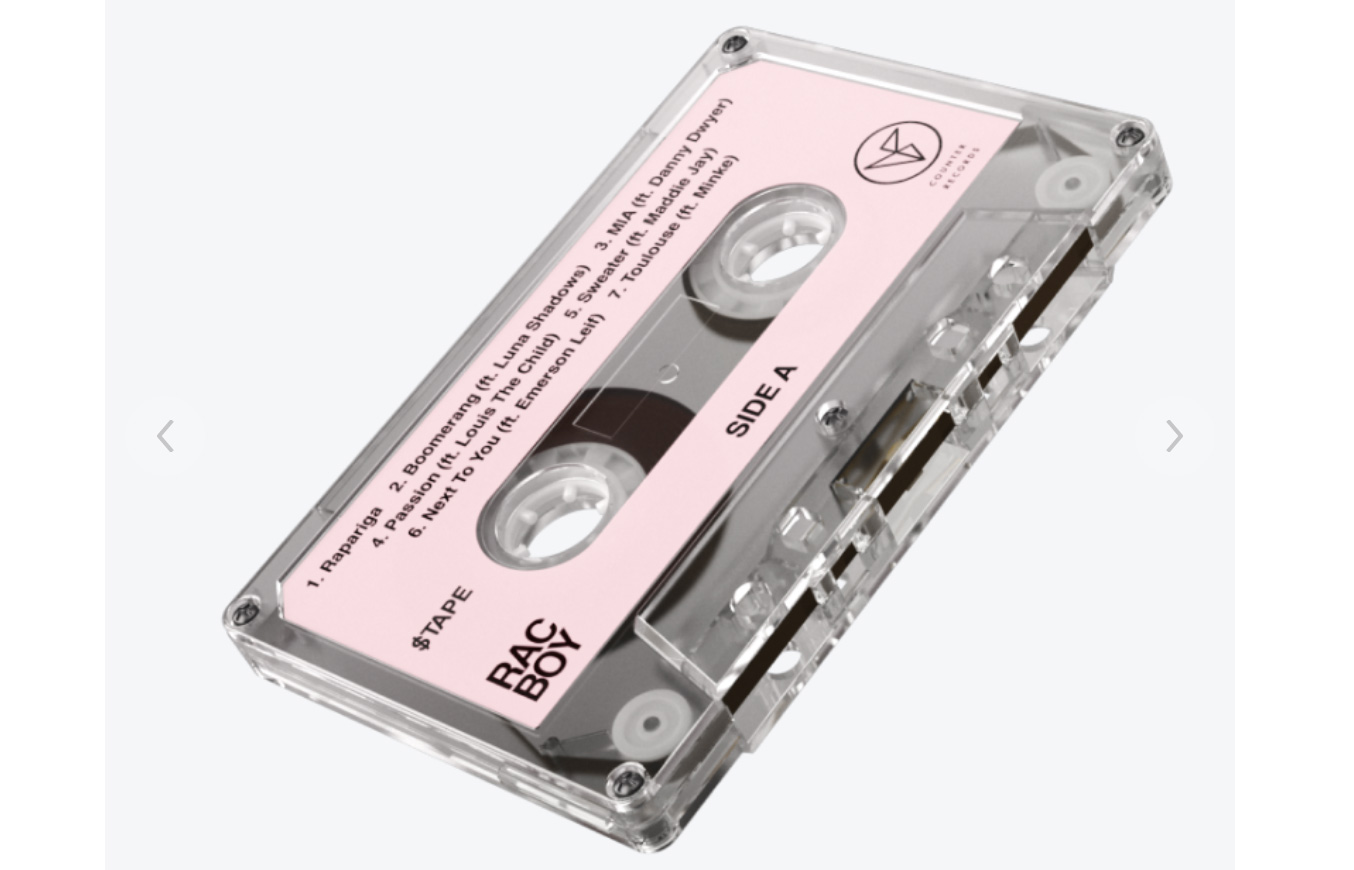
安德烈•安霍斯是一名来自波特兰的音乐家,在其歌迷圈中被称为RAC,2017年,凭借一首重混歌曲《Taring Me Up》,安德烈一举夺得格莱美奖,但这种成功并没有让他的生活容易多少。他指责数字经济没有重视词曲作家和其他创造性艺术家的劳动。
安霍斯表示:“音乐产业彻底完了,大家都说‘Spotify将会拯救我们’,但我不信这一套。他们自己都赚不到钱,不然也不会转型做播客了。”
出于对数字经济的失望,安霍斯携手数名运动鞋、连帽衫设计师投入了一家初创企业的怀抱,希望能在实体商品转售市场创造新的收入来源。以安霍斯为例,在狂热歌迷的推动下,他的新专辑限量版卡带(如下图所示)已被炒至950美元的高价。

这家初创公司名为Zora,其创始人声称,该公司已经解决了他们所谓的“Yeezy”问题。所谓“Yeezy”问题指的是“Yeezy”运动鞋的炒作现象:坎耶•韦斯特以200美元价格推出的限量版Yeezy运动鞋每次都会被人很快抢购一空,随后这些运动鞋又会被以2000美元的高价转售出去。
Zora的工作则是让艺术家和设计师通过创建数字通证来获取部分转售利润,每枚通证对应一件商品,可以用来兑换商品,也可以加价转售他人。在竞购的热潮之中,创作者不但可以将自己的作品售出更高的价格,还能在通证转售时获取一定收益。
负责Zora业务发展事务的迪•戈恩斯称,Zora的主要目标受众是那些所谓的“潮货炒家”,即某一品牌或某位创作者的超级粉丝。与Zora有合作关系的创作者还包括“鞋圈”的知名耐克设计师杰夫•斯特普尔,他通过Zora平台出售限量版球鞋。(下图球鞋挂牌价为160美元,最终以2000美元的价格出售)。
戈恩斯拥有网红营销的背景,他表示,Zora正在与NBA及NBA球员就售卖比赛中穿过的球衣进行协商。

虽然粉丝是Zora用户群的核心,但其商业模式的运转也离不开鼓励投机者购买数字通证以及新商品上架时的交易热潮。为了卖出更好的价格,投机者有时可以持有通证长达一年之久。在最终被用于兑换基础商品之后,通证将被销毁。
戈恩斯和Zora创始人雅各布•霍恩都是加密货币巨头Coinbase的元老级员工,他们借助区块链技术为Zora上的各种商品创建了一一对应的通证。比特币依托的也是区块链技术,区别在于其是借助这种技术来创建不可篡改的所有权记录。
区块链技术为Zora系统增加了一层安全保障,但也让Zora上的购买流程变得非常复杂:消费者要想获得Zora通证、再出售获利,首先需要在Zora上创建一个数字钱包,还要通过Coinbase使用所谓的稳定币(加密货币中的“美元”)对钱包进行入金操作。虽然对潮货炒家而言,这一繁琐流程可能仍然值得一试,但普通消费者可能就会望而却步了。与此同时,对于那些纯粹想要购买商品的人而言,只要用信用卡就够了。
Zora并非首家希望借助加密货币通证推高稀有商品价值的企业。总部位于温哥华的Dapper Labs也在销售一系列与Dr.Seuss、NBA等知名品牌相关的数字商品,并将“区块链存证、独一无二”作为这些产品的卖点。另一家名为Nifty的公司也在从事相似业务,让艺术家通过该公司的平台销售独特的数字印刷作品与绘画作品,此前因起诉Facebook而声名鹊起的文克莱沃斯双胞胎兄弟是该公司的支持者。
然而,这些数字产品企业当前所代表的仍然只是一个很小的利基市场,没人知道它们何时能够得到主流消费者的认可,如果能的话。不过由于Zora出售的是倍受粉丝追捧且独家销售的鞋、卡带、帽衫等实体商品,所以可能更有机会实现突破。
长期以来,转售利润都是中间商的囊中之物,对安霍斯来说,Zora平台给了他赚取这部分利润的机会,不过他也承认,这种合作在很大程度上具有实验性质。
“事实证明,音乐确实还是有价值的,”他如是说到。(财富中文网)
译者:梁宇
审校:夏林
安德烈•安霍斯是一名来自波特兰的音乐家,在其歌迷圈中被称为RAC,2017年,凭借一首重混歌曲《Taring Me Up》,安德烈一举夺得格莱美奖,但这种成功并没有让他的生活容易多少。他指责数字经济没有重视词曲作家和其他创造性艺术家的劳动。
安霍斯表示:“音乐产业彻底完了,大家都说‘Spotify将会拯救我们’,但我不信这一套。他们自己都赚不到钱,不然也不会转型做播客了。”
出于对数字经济的失望,安霍斯携手数名运动鞋、连帽衫设计师投入了一家初创企业的怀抱,希望能在实体商品转售市场创造新的收入来源。以安霍斯为例,在狂热歌迷的推动下,他的新专辑限量版卡带(如下图所示)已被炒至950美元的高价。
这家初创公司名为Zora,其创始人声称,该公司已经解决了他们所谓的“Yeezy”问题。所谓“Yeezy”问题指的是“Yeezy”运动鞋的炒作现象:坎耶•韦斯特以200美元价格推出的限量版Yeezy运动鞋每次都会被人很快抢购一空,随后这些运动鞋又会被以2000美元的高价转售出去。
Zora的工作则是让艺术家和设计师通过创建数字通证来获取部分转售利润,每枚通证对应一件商品,可以用来兑换商品,也可以加价转售他人。在竞购的热潮之中,创作者不但可以将自己的作品售出更高的价格,还能在通证转售时获取一定收益。
负责Zora业务发展事务的迪•戈恩斯称,Zora的主要目标受众是那些所谓的“潮货炒家”,即某一品牌或某位创作者的超级粉丝。与Zora有合作关系的创作者还包括“鞋圈”的知名耐克设计师杰夫•斯特普尔,他通过Zora平台出售限量版球鞋。(下图球鞋挂牌价为160美元,最终以2000美元的价格出售)。
戈恩斯拥有网红营销的背景,他表示,Zora正在与NBA及NBA球员就售卖比赛中穿过的球衣进行协商。
虽然粉丝是Zora用户群的核心,但其商业模式的运转也离不开鼓励投机者购买数字通证以及新商品上架时的交易热潮。为了卖出更好的价格,投机者有时可以持有通证长达一年之久。在最终被用于兑换基础商品之后,通证将被销毁。
戈恩斯和Zora创始人雅各布•霍恩都是加密货币巨头Coinbase的元老级员工,他们借助区块链技术为Zora上的各种商品创建了一一对应的通证。比特币依托的也是区块链技术,区别在于其是借助这种技术来创建不可篡改的所有权记录。
区块链技术为Zora系统增加了一层安全保障,但也让Zora上的购买流程变得非常复杂:消费者要想获得Zora通证、再出售获利,首先需要在Zora上创建一个数字钱包,还要通过Coinbase使用所谓的稳定币(加密货币中的“美元”)对钱包进行入金操作。虽然对潮货炒家而言,这一繁琐流程可能仍然值得一试,但普通消费者可能就会望而却步了。与此同时,对于那些纯粹想要购买商品的人而言,只要用信用卡就够了。
Zora并非首家希望借助加密货币通证推高稀有商品价值的企业。总部位于温哥华的Dapper Labs也在销售一系列与Dr.Seuss、NBA等知名品牌相关的数字商品,并将“区块链存证、独一无二”作为这些产品的卖点。另一家名为Nifty的公司也在从事相似业务,让艺术家通过该公司的平台销售独特的数字印刷作品与绘画作品,此前因起诉Facebook而声名鹊起的文克莱沃斯双胞胎兄弟是该公司的支持者。
然而,这些数字产品企业当前所代表的仍然只是一个很小的利基市场,没人知道它们何时能够得到主流消费者的认可,如果能的话。不过由于Zora出售的是倍受粉丝追捧且独家销售的鞋、卡带、帽衫等实体商品,所以可能更有机会实现突破。
长期以来,转售利润都是中间商的囊中之物,对安霍斯来说,Zora平台给了他赚取这部分利润的机会,不过他也承认,这种合作在很大程度上具有实验性质。
“事实证明,音乐确实还是有价值的,”他如是说到。(财富中文网)
译者:梁宇
审校:夏林
Grammy winner RAC JULES DAVIS
Andre Anjos, known to his fans as RAC, won a Grammy for his 2017 remix of the song "Tearing Me Up," but this success has not made it easy for the Portland musician to make a living. He blames a digital economy that fails to value the labor of songwriters and other creative artists.
"The music industry is fundamentally broken," says Anjos. "Everyone says 'Spotify is going to save us' but I don’t believe it. They’re not profitable, which is why they're pivoting to podcasts."
Frustration with the digital economy has led Anjos, along with a handful of sneaker and hoodie designers, to embrace a new startup in a bid to create a new revenue stream based on a resale market for physical items. In Anjos' case, a frenzy among his fans resulted in a limited edition cassette (like the one seen below) of his new album selling for $950.
The startup is called Zora and its founders claim it has solved what they call the "Yeezy problem"—a reference to the phenomenon of Kanye West releasing a limited edition pair of Yeezy sneakers for $200, only to have a handful of people snap them up and resell them for $2,000.
The premise of Zora is to let artists and designers capture part of that resale value by creating a digital token that can be redeemed for merchandise, or else sold to someone else for a higher price. In the case of a bidding frenzy, the creator not only pockets a higher ultimate price, but part of the fees collected when the token is resold.
Zora's head of business development, Dee Goens, says Zora is primarily aimed at "hype beasts"—those consumers who are super fans of a given brand or creator. Other creators using Zora include Jeff Staple, a Nikedesigner famous in sneakerhead circles, who has been selling limited edition shoes on the platform. (The pair below fetched $2000 after being listed initially at $160).
Goens, who has a background in influencer marketing, says Zora is also in talks with the NBA and its players to sell used game jerseys.
While fans are the core of Zora's user base, its business model also relies on encouraging speculators to buy the digital tokens, and creating a burst of trading activity when a new piece of merchandise drops. These speculators can hold the token for up to a year in hopes of getting a better price. When the token is finally redeemed for the underlying piece of merchandise, the token is destroyed.
Both Goens and Zora founder's, Jacob Horne, are veterans of the cryptocurrency giant Coinbase. They deployed blockchain—the same technology that powers Bitcoin to create a tamper-proof record of ownership—to create the tokens that are used as proxies for the merchandise on Zora.
The blockchain element adds a layer of security, but also complexity to Zora's buying process: those wishing to obtain a token and try sell it for more must create a digital wallet on Zora and fund it with so-called stablecoins (digital versions of the US dollar) from Coinbase. This process is likely to prove daunting to casual consumers, though the "hype beasts" among them may decide the rigamarole is worth it. Meanwhile others who simply want to purchase the item can use a credit card.
Zora is not the first company to use cryptocurrency tokens to try and drive up the value of scarce goods. Vancouver-based Dapper Labs is selling an array of digital merchandise tied to famous brands like Dr. Seuss and the NBA, and touting them as unique items stored on a blockchain. In a similar vein, a company called Nifty, backed by the Winklevoss twins of early Facebook fame, is letting artists sell unique digital prints and painting.
These digital goods ventures, however, represent a tiny niche market and it's unclear when, if ever, mainstream consumers will embrace them. Zora, however, may be in a better position for a breakout since it is selling physical stuff—shoes, cassettes, hoodies and so on—that fans crave and that can't be found elsewhere.
For Anjos, aka RAC, a platform like Zora—which he concedes is very much an experiment—represents a chance to capture the resale cash that has long been pocketed by middlemen.
"It turns out music does have value," he says.






